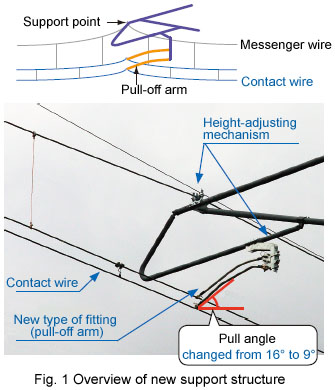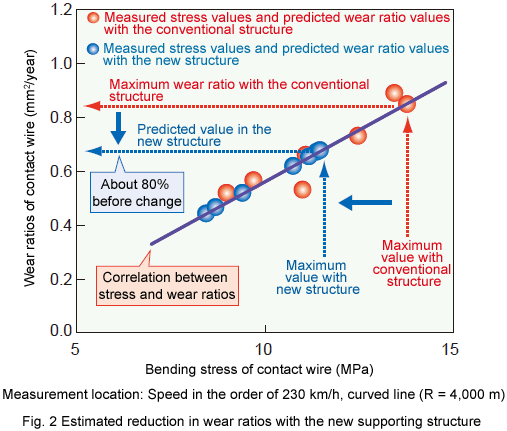In the vicinity of supporting points on overhead contact lines, local pulling-up of contact wires caused by pull-off arms and faulty supporting point heights can cause excessive contact force on pantographs, thus increasing the likelihood of local wear on contact wires. In particular, this trend is remarkable in curved sections and high-speed running sections, so improvements to reduce maintenance costs are desired.
Against this background, the RTRI developed a new type of fitting that can reduce the pulling-up of contact wires down to the order of 60% of the conventional amount, and also introduced a new support structure with a mechanism that can readily adjust faulty support-point heights. We devised a composition of materials and a shape for the new type of fitting, and examined the mounting angle (conventionally 16 degrees) by simulation etc. with a view to securing strength and improved current collection characteristics. The mounting angle was set to 9 degrees, which is the optimum value (Fig. 1). As a result, it was confirmed that the amount of pull-up on contact wires can be inhibited, and that pantographs can pass smoothly even near support points. Tests in curved sections of commercial lines revealed that the new support structure helps to reduce pulling-up near support points compared with the conventional support structure, and that the maximum value of bending stress generated in contact wires when a pantograph passes can be reduced by a factor in the order of 16%. It can be predicted that it will be possible to reduce wear ratios by around 20% in curved sections because of the high correlation between bending stress and wear ratios in the contact wires and reductions in stress (Fig. 2). In addition, bending stress in contact wires near supporting points increases with speed, and the local pulling-up of contact wires is lessened. Accordingly, a wear-ratio reduction effect can be expected even in high-speed running sections in the same way as with curved lines.
|



